Officials in central Italy began early yesterday to assess the damage caused by a pair of strong earthquakes in the same region of central Italy hit by a deadly earthquake in August, as an appeal went out for temporary housing adequate for the cold mountain temperatures.
Thousands of people spent the night in their cars following the pair of quakes that struck late in the evening, sending residents into the streets in pouring rain, too late for authorities to come up with adequate shelter.
A series of small shocks overnight, including two registering magnitudes above 4 before dawn, further unsettled residents.
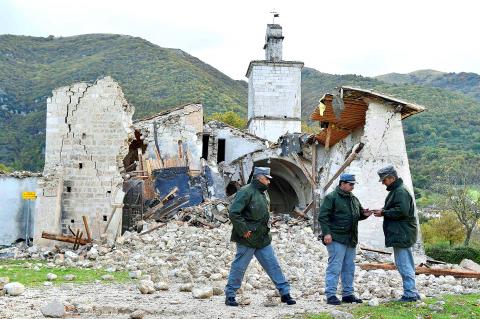
Photo: Reuters
The morning after the quakes, there remained no reports of serious injuries or signs of people trapped in rubble. Civil Protection Department head Fabrizio Curcio said it appeared that the situation “is not as catastrophic” as it could have been.
A 73-year-old man died of a heart attack, possibly brought on by the quakes, local authorities told the ANSA news agency.
Mayors of towns scattered in the mountain region spanning the Umbria and Marche regions say many more homes were rendered uninhabitable, on top of those damaged in the August quake, while historic structures that survived previous temblors had succumbed this time.
Camerino Mayor Gianluca Pasqui said the town’s historic bell tower had collapsed, but added that reconstruction work after a 6.1 quake in 1997 appeared to have contributed to the absence of serious injury.
“I can say that the city didn’t have victims. That means that even if there is a lot of damage probably the reconstruction in the historic center was done in a correct and adequate manner. Because otherwise, we would be speaking of something else,” Pasqui told Sky TG24.
Umbria President Catiuscia Marini told RAI state television that officials were scrambling to come up with temporary housing, mindful that with winter approaching and temperatures dropping, tents cannot be deployed as they were after the August quake. The concern for the predominantly elderly population of the remote mountain region was repeated by other officials.
Marini said that after the quakes many people would be fearful of staying even in hotels deemed safe, and that solutions like campers were being considered.
“We don’t have injured, we have people who are very afraid, who have anxiety, especially the elderly,” she said.
In Visso, Mayor Giuliano Passaglini said he was only able to provide shelter for a couple hundred residents overnight, and most people spent the night in their cars. About 800 people were without shelter in Visso.
Firefighters were helping residents to retrieve objects from their homes in the red zone. Most were intact, showing only cracks.
The first quake struck at 7:10pm and carried a magnitude of 5.4, but the second one a little more than two hours later was eight times stronger at 6.1, according to the US Geological Survey.
Officials said the fact that people had already left their homes when the second quake hit probably saved lives.
“Many houses collapsed,” the mayor of hard-hit Ussita, Marco Rinaldi, told Sky TG24. “The facade of the church collapsed. By now I have felt many earthquakes. This is the strongest of my life. It was something terrible.”
Rinaldi said two elderly people were rescued from their home, where they were trapped, and appeared to be in good condition.
Calling it “apocalyptic,” he said the town and its hamlets were “finished.”
In addition to the town’s church, the parish and other buildings had suffered heavy damage, he said.
A church crumbled in the ancient Perugian town of Norcia, famed for its Benedictine monastery and its cured meats. A bell-tower damaged on Aug. 24 fell and crushed a building in Camerino, ANSA reported.
Elsewhere, buildings were damaged, though many were in zones that were declared off-limits after the Aug. 24 quake that flattened parts of three towns.
Italian Prime Minister Matteo Renzi, who cut short a visit to southern Italy to monitor the quake response, tweeted “all of Italy is embracing those hit once again.”
The pope said in a message on Twitter that he is praying for the people hit by the quake.
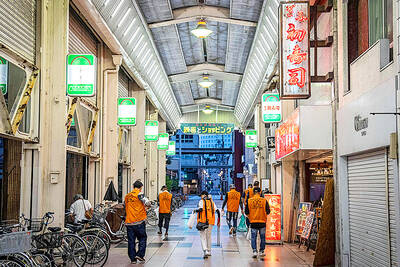
A missing fingertip offers a clue to Mako Nishimura’s criminal past as one of Japan’s few female yakuza, but after clawing her way out of the underworld, she now spends her days helping other retired gangsters reintegrate into society. The multibillion-dollar yakuza organized crime network has long ruled over Japan’s drug rings, illicit gambling dens and sex trade. In the past few years, the empire has started to crumble as members have dwindled and laws targeting mafia are tightened. An intensifying police crackdown has shrunk yakuza forces nationwide, with their numbers dipping below 20,000 last year for the first time since records
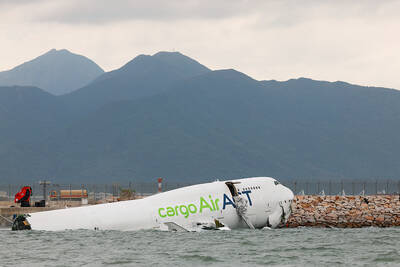
CAUSE UNKNOWN: Weather and runway conditions were suitable for flight operations at the time of the accident, and no distress signal was sent, authorities said A cargo aircraft skidded off the runway into the sea at Hong Kong International Airport early yesterday, killing two ground crew in a patrol car, in one of the worst accidents in the airport’s 27-year history. The incident occurred at about 3:50am, when the plane is suspected to have lost control upon landing, veering off the runway and crashing through a fence, the Airport Authority Hong Kong said. The jet hit a security patrol car on the perimeter road outside the runway zone, which then fell into the water, it said in a statement. The four crew members on the plane, which
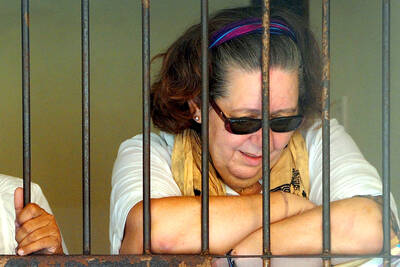
Indonesia was to sign an agreement to repatriate two British nationals, including a grandmother languishing on death row for drug-related crimes, an Indonesian government source said yesterday. “The practical arrangement will be signed today. The transfer will be done immediately after the technical side of the transfer is agreed,” the source said, identifying Lindsay Sandiford and 35-year-old Shahab Shahabadi as the people being transferred. Sandiford, a grandmother, was sentenced to death on the island of Bali in 2013 after she was convicted of trafficking drugs. Customs officers found cocaine worth an estimated US$2.14 million hidden in a false bottom in Sandiford’s suitcase when
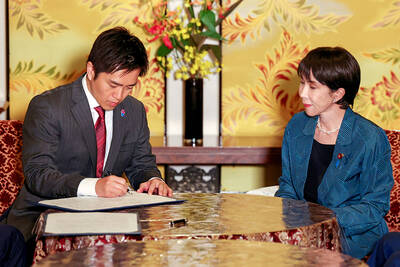
Japan’s ruling Liberal Democratic Party (LDP) and its junior partner yesterday signed a coalition deal, paving the way for Sanae Takaichi to become the nation’s first female prime minister. The 11th-hour agreement with the Japan Innovation Party (JIP) came just a day before the lower house was due to vote on Takaichi’s appointment as the fifth prime minister in as many years. If she wins, she will take office the same day. “I’m very much looking forward to working with you on efforts to make Japan’s economy stronger, and to reshape Japan as a country that can be responsible for future generations,”